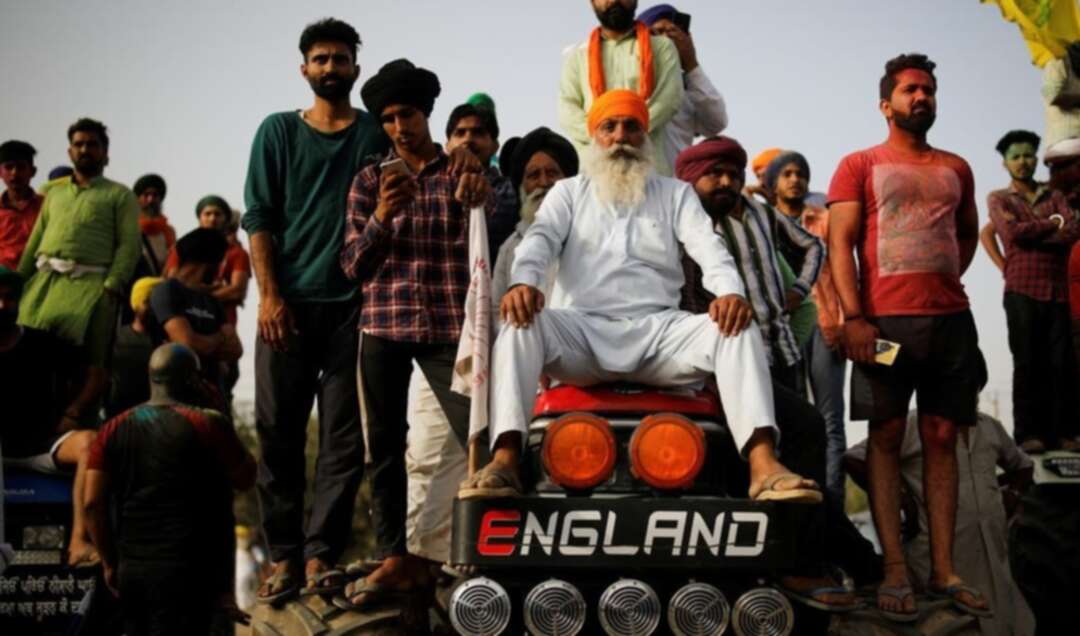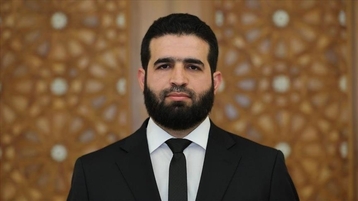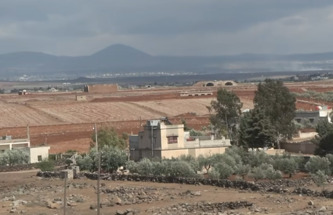-
India’s worsening water crisis at the heart of farm protests

Every year, Swarn Singh sows rice in his fields, knowing that the thirsty crop is draining northern India’s Punjab of its groundwater. But Singh says he has no choice, adding, “We’d rather plant crops that need less water.”
The 32-year-old farmer and school teacher lives in Ransih Kalan village in the state’s Moga district, where green fields surrounding its wide roads and large houses belie the reality that the region is among India’s most parched and its once-prosperous agricultural system is now broken.
India’s water crisis looms over an agrarian crisis that has been brewing for decades. At its heart is a conundrum: the government has been subsidizing the cultivation of rice in northern India, but such water-intensive crops have dramatically lowered the groundwater table.
Every third house in Ransih Kalan — a community of nearly 3,000, less than 100 kilometers (62 miles) from India’s border with Pakistan — bears flags supporting thousands of farmers hunkered down outside New Delhi since November to protest three laws Prime Minister Narendra Modi says will modernize agriculture.
Singh says his village’s farmers agree changes are needed but fear these laws will only make matters worse, leaving them at the mercy of big corporations. The laws don’t address the region’s water crisis. But Singh said that if guaranteed prices for all crops were to become a legal right, farmers would shift away from thirsty crops.
Home to a fifth of the world’s population, India has only 4 percent of the world’s water. But the country is the largest extractor of groundwater in the world, with 90 percent used for agriculture.
Nowhere is the water shortage more pronounced than in Punjab, where India’s government encouraged cultivation of wheat and rice in the 1960s and has since been buying the staples at fixed prices to shore up national reserves.
Wheat was a traditional crop, along with mung beans or peanuts, said Singh’s father, Bhupinder Singh, 62. But he and experts say a pound of rice needs up to 500 gallons (2,273 liters) of water — and irrigation canals couldn’t supply enough as more farmers switched to the grain.
Farmers turned to well water. When the government started providing free electricity to run well pumps in 1997, Punjab rice raising rocketed — from 500 square kilometers (193 square miles) in 1975 to 31,000 square kilometers (11,969 square miles).
But groundwater levels plummeted as underground pumps proliferated, with over 1.2 million by 2012. And a 2017 federal report warned that the state of 27 million people would exhaust its groundwater by 2039.
“It’s becoming a desert,” said Kirpal Singh Aulakh, an agricultural scientist and former vice chancellor of Punjab Agricultural University.
The looming calamity isn’t news to the Singhs. They had to spend $6,600 to install a pump for a nearly 200-foot (60-meter) borehole. And successive years of planting the same crops leached their village’s soil of nutrients, forcing them to rely on expensive fertilizers.
Rising costs have forced the family into debt, and the certainty of selling to their crops to the government is their only way of staying afloat. “All of Punjab is trapped,” the son said.
Protesting farmers fear the new laws signal that the government wants to reduce its role in agriculture and that guaranteed prices for their crops will end.
The government does fix prices for crops other than wheat and rice, including corn. But Aulakh said these products aren’t purchased for federal reserves and traders in the private market pay much lower prices for them, resulting in farmers feeling “cheated.”
 Farmers participate in a protest march towards the capital during India's Republic Day celebrations in New Delhi, India, Tuesday, Jan. 26, 2021. (AP)
Farmers participate in a protest march towards the capital during India's Republic Day celebrations in New Delhi, India, Tuesday, Jan. 26, 2021. (AP)Aulakh, who has sat on government committees that discussed crop diversification in Punjab, said farmers would switch to more suitable crops if they knew they’d be compensated by the government. “We can’t blame the farmers,” he said.
India’s agricultural and water ministries did not respond to emailed requests for comment.
More than 86 percent of India’s farmers work on less than than 2 hectares (4.9 acres). So the falling groundwater table means these small farmers spend increasingly more money to pump water for their crops and this is widening inequity, said Balsher Singh Sidhu, a University of British Columbia doctoral student studying climate change impacts on agriculture.
Sidhu compared the available groundwater to a bank account where withdrawals far exceed deposits. “Today everyone has access to water, but we can’t say the same about tomorrow,” he said.
Climate change has made the monsoon rains -- a lifeline for over half of India’s cultivated area -- unpredictable and left farmers even more reliant on groundwater. Rice requires standing water in fields. But hotter summers are increasing the amount lost due to evaporation.
Rice farmer Mahinder Singh, 73, said he tried planting corn once but private buyers paid him only a fraction of the prices set by the government. “We will die of hunger,” if the water runs out, he added.
India’s food reserves are overflowing, leading to waste, but malnutrition is intensifying and experts fear future water shortages could make it worse.
“The richer people can afford to (buy) fruits and vegetables,” said Upmanu Lall, director of the Columbia Water Center at Columbia University. “Poor people do not, other than what they can scavenge.”
Residents of Ransih Kalan have begun taking steps to conserve water.
Villagers have installed a sewage treatment plant, and the treated water is used for irrigation. They’ve also built plants to harvest rainwater and divert it into a man-made lake. In the middle is a 10-foot tall (3 meters) statue of a dinosaur.
It’s a reminder, says Preet Inderpal Singh, the 30-year-old village headman, “That if people don’t save every drop of water, people would become extinct, like dinosaurs.”
source: The Associated Press
Image source: Reuters
Levant
You May Also Like
Popular Posts
Caricature
BENEFIT Sponsors BuildHer...
- April 23, 2025
BENEFIT, the Kingdom’s innovator and leading company in Fintech and electronic financial transactions service, has sponsored the BuildHer CityHack 2025 Hackathon, a two-day event spearheaded by the College of Engineering and Technology at the Royal University for Women (RUW).
Aimed at secondary school students, the event brought together a distinguished group of academic professionals and technology experts to mentor and inspire young participants.
More than 100 high school students from across the Kingdom of Bahrain took part in the hackathon, which featured an intensive programme of training workshops and hands-on sessions. These activities were tailored to enhance participants’ critical thinking, collaborative problem-solving, and team-building capabilities, while also encouraging the development of practical and sustainable solutions to contemporary challenges using modern technological tools.
BENEFIT’s Chief Executive Mr. Abdulwahed AlJanahi, commented: “Our support for this educational hackathon reflects our long-term strategic vision to nurture the talents of emerging national youth and empower the next generation of accomplished female leaders in technology. By fostering creativity and innovation, we aim to contribute meaningfully to Bahrain’s comprehensive development goals and align with the aspirations outlined in the Kingdom’s Vision 2030—an ambition in which BENEFIT plays a central role.”
Professor Riyadh Yousif Hamzah, President of the Royal University for Women, commented: “This initiative reflects our commitment to advancing women in STEM fields. We're cultivating a generation of creative, solution-driven female leaders who will drive national development. Our partnership with BENEFIT exemplifies the powerful synergy between academia and private sector in supporting educational innovation.”
Hanan Abdulla Hasan, Senior Manager, PR & Communication at BENEFIT, said: “We are honoured to collaborate with RUW in supporting this remarkable technology-focused event. It highlights our commitment to social responsibility, and our ongoing efforts to enhance the digital and innovation capabilities of young Bahraini women and foster their ability to harness technological tools in the service of a smarter, more sustainable future.”
For his part, Dr. Humam ElAgha, Acting Dean of the College of Engineering and Technology at the University, said: “BuildHer CityHack 2025 embodies our hands-on approach to education. By tackling real-world problems through creative thinking and sustainable solutions, we're preparing women to thrive in the knowledge economy – a cornerstone of the University's vision.”
opinion
Report
ads
Newsletter
Subscribe to our mailing list to get the new updates!





















